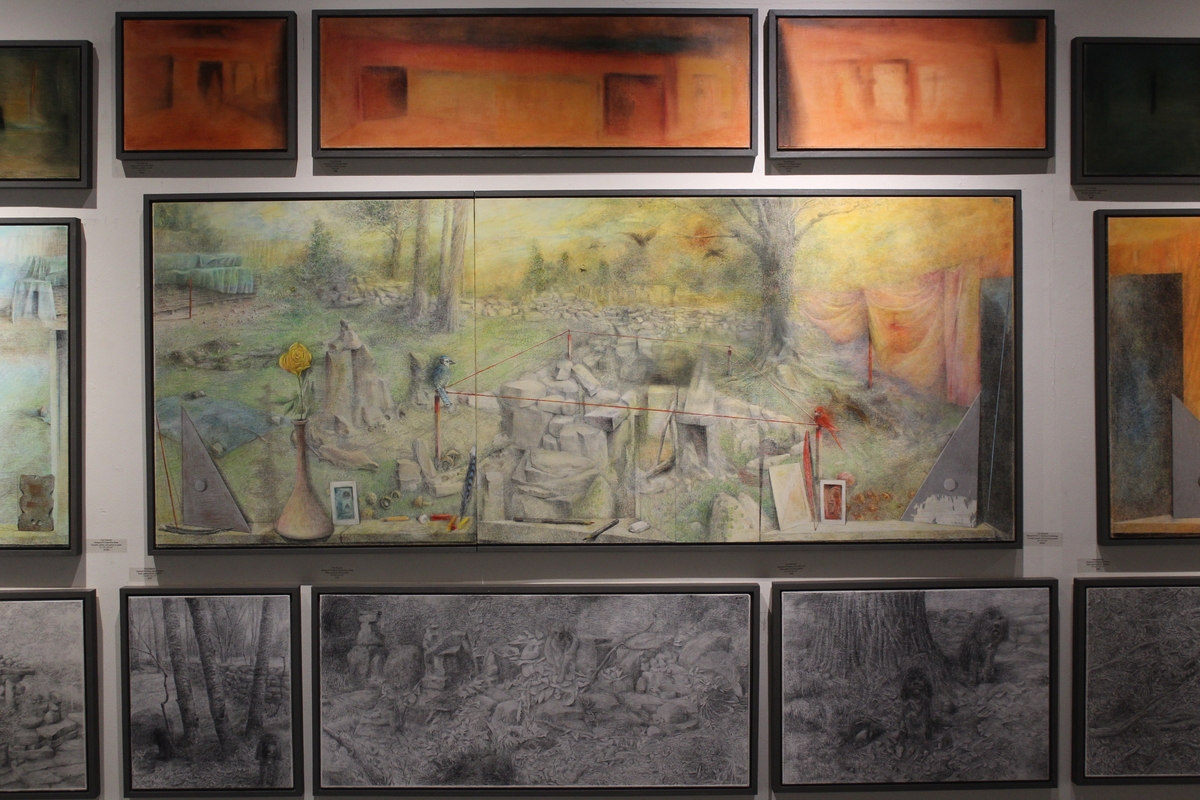
A cluster of paintings on the wall of the gallery all border a central piece, as if feeding it, which in a sense they do. The central piece holds the others together. In it, a yard bordered by trees is the site of some kind of excavation, roped off. Something is being unearthed there, the ruins of a house, or something still older, maybe. But instead of a crew with tools, the only animals in sight are a cardinal and a bluejay, watching over the proceedings in a moment that’s both funny and a little magical, a flight of fancy on the part of the artist, though very much grounded in reality.
That central piece, by artist Tom Edwards, a part of a joint show from him and fellow artist Sean Gallagher, running now at Kehler Liddell Gallery in Westville through June 26. The accompanying description is refreshingly simple: “two artists work to create a place of memory, observed and imagined, romantic and revered.” In Edwards’s part of the show, collective titled “Backyard Archeology,” the artist “excavates his backyard of ideas and observations.” In Gallagher’s half, called “What She Left and What She Kept,” the painter “paints a tribute to his grandmother and heritage of West Cork Ireland.” The descriptions make the show sound more disparate than it is. The pairing of the two bodies of work makes it possible to draw connections between them. Both painters, in their attention to the details and energy of the landscapes they depict, show that the faithful rendering of a place can be an examination of the past, whether it’s the history of a location or a family. It also suggests that the connection between the painter and the subject can charge either one with emotion.

Fittingly, Edwards in a sense shows the viewer the process by which he arrived at the central canvas. First is a detailed sketch of a yard in Killington; the artist could have kept everything just as realistic as this sketch, had he chosen to.

Elsewhere, a series of small paintings labeled as conceptual pieces shows Edwards’s facility with working more abstractly and geometrically as well. The two elements are brought together in the central painting. Edwards’s artistic excavation of the yard is also an investigation into his own predilections as a painter, exploring what can happen if you loose the bounds of realism just a bit, and let geometric shapes into the same space, whether it’s the angular ruins being uncovered, the sharp quadrilateral made by the rope, or the shapes in the foreground, arranged on the shelf of a picture window, as if the artist is tipping his hand, letting us know he’s been indoors the whole time.

Meanwhile, the sheer number of paintings in Gallagher’s side of the show is itself a tell. If Gallagher was looking to understand his grandmother better, the panoply of works suggest that he looked everywhere to find that understanding. There was no single place that illuminated everything — no family home, perhaps, or a school attended, or a street that he knew contained a trove of information about his grandmother’s past. Rather, Gallagher combed the hillside, making painting after painting after painting. The kinetic nature in the images suggest he worked quickly, almost as if running out of time, until he captured the essence of what he thought he wanted — except that no single piece took it all in.

But in the end, the paintings capture more about Gallagher’s personal journey than a photograph would. They render the place as Gallagher found it and saw it. But in their brushstrokes, they also mark the time he spent there. Perhaps he painted them in plein air, and maybe he worked from photographs, but either way, each stroke is a second spent looking, really looking, at the landscape, taking it in, getting the details of the geography of the land and the movement of wind, water, and plants. Less obviously but just as importantly as in Edwards’s paintings, Gallagher’s pieces show his process, and the time and concentration he spent exploring his craft and communing with the past.
“Backyard Archeology” and “What She Left and What She Kept” are running now at Kehler Liddell Gallery, 873 Whalley Ave., through June 26. Visit the gallery’s website for hours and more information.